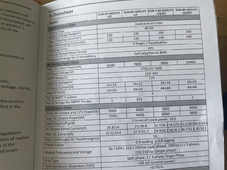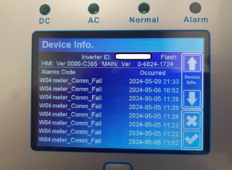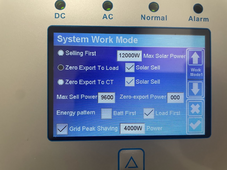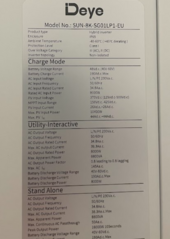Hi all
I have a clipping issue on my installation. My installation consist of
- Inverter: Deye sun-8k-sg01lp1-eu
- Solar Panels: 18 JA Solar 550W.
- Wiring: Two MPPT in use. First one with 8 panels in series. Second one with two string of 5 serial panels (5+5)
I have a problem in the production that can be easily spotted on the main production charts (see below). My conclusion is that the MPPT 2 (5+5 panels) is clipping at 20A. However the device specifications on the User Manual and Inverter sticker indicate a maximum of 26A. Please let me share some images to back my findings:

Day One Sample (31/05). Current peaks at 24A at 12:23 then it is clip at 20A for the rest of the day till the evening. There are no shadows afecting at that time.

Day Two Sample (03/06). Current peaks at 25.10A at 13:04 then it is clip at 20A for the rest of the day till the evening. There are no shadows afecting at that time.
The device specifies a max PV Input current of 26A both on the side sticker and user manual.

Where the issue might be?
1. I have seen other discussions that the PV Input may be limited to 20A by the manufacturer. Please see link below.
Is that correct?
2. I have been scammed and my inverter is an older version with a fake sticker that only supports 20A max PV current.
3. I required a firmware upgrade. Is my current version the latest (see below)? How to upgrade the device?
Current version 0-6024-1724

4. I have missconfigured the device. See system work configuration below

Please share your thought and thanks for your help!
I have a clipping issue on my installation. My installation consist of
- Inverter: Deye sun-8k-sg01lp1-eu
- Solar Panels: 18 JA Solar 550W.
- Wiring: Two MPPT in use. First one with 8 panels in series. Second one with two string of 5 serial panels (5+5)
I have a problem in the production that can be easily spotted on the main production charts (see below). My conclusion is that the MPPT 2 (5+5 panels) is clipping at 20A. However the device specifications on the User Manual and Inverter sticker indicate a maximum of 26A. Please let me share some images to back my findings:

Day One Sample (31/05). Current peaks at 24A at 12:23 then it is clip at 20A for the rest of the day till the evening. There are no shadows afecting at that time.

Day Two Sample (03/06). Current peaks at 25.10A at 13:04 then it is clip at 20A for the rest of the day till the evening. There are no shadows afecting at that time.
The device specifies a max PV Input current of 26A both on the side sticker and user manual.

Where the issue might be?
1. I have seen other discussions that the PV Input may be limited to 20A by the manufacturer. Please see link below.
Is that correct?
2. I have been scammed and my inverter is an older version with a fake sticker that only supports 20A max PV current.
3. I required a firmware upgrade. Is my current version the latest (see below)? How to upgrade the device?
Current version 0-6024-1724

4. I have missconfigured the device. See system work configuration below

Please share your thought and thanks for your help!
Last edited:



